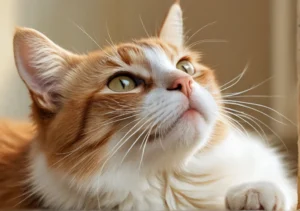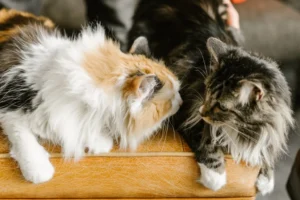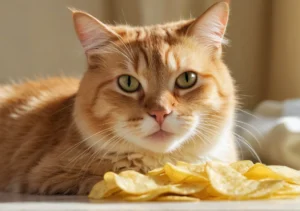Cats and bread – it’s a peculiar attraction that many cat owners have noticed at some point. But why are cats so drawn to this simple baked good? Let’s delve into the fascinating reasons behind this behavior.
Cats’ Natural Instincts
Cats’ natural instincts and behaviors play a significant role in why they are attracted to bread. As natural hunters and scavengers, cats are drawn to the smell of food, especially carbohydrates like those found in bread. In the wild, cats would often rely on their sense of smell to locate potential food sources, making them highly responsive to any scent that hints at a meal.
Furthermore, the texture of bread may also mimic that of prey, triggering a cat’s instinct to paw at and explore objects that resemble potential prey. This innate curiosity and hunting behavior can explain why cats sometimes show interest in bread, even though they may not ultimately consume it.
On top of that, cats are known for their selective eating habits. They may be attracted to bread not necessarily because they want to eat it, but because it presents a new and interesting object to investigate. Therefore, their attraction to bread may be more about exploration and curiosity rather than a genuine desire for the food itself.
The Smell Factor
The enticing aroma of bread can be particularly appealing to a cat’s keen sense of smell. Cats have a highly developed sense of smell, with a significantly larger number of scent receptors compared to humans. This means that cats can detect a wide range of scents with incredible sensitivity, making them particularly sensitive to the delicious fragrance of freshly baked bread.
The smell of bread baking in the oven releases compounds that cats may find irresistible, drawing them to investigate further. Additionally, the yeast used in bread-making gives off a unique scent that can be enticing to cats. This alluring aroma may be enough to pique a cat’s interest and prompt them to investigate the source of the delicious smell.
In addition to the olfactory appeal, the texture and softness of bread may also be appealing to cats, especially if they enjoy kneading and pawing at soft surfaces. The combination of a tempting aroma and a tactile stimulation may make bread an intriguing object for cats to explore. So, next time you see your furry friend hovering around a loaf of bread, remember that their keen sense of smell and natural curiosity are likely the driving forces behind their interest.
#
Texture Temptations
Have you ever wondered why cats seem so attracted to bread? Well, one reason could be the texture. Cats are known for enjoying textures that are soft and doughy, similar to the feel of bread. The squishy and malleable texture of bread may mimic certain textures that cats find satisfying or enjoyable. It’s like a little sensory adventure for them, exploring the feel of the bread with their paws or mouth.
Curiosity and Exploration
When it comes to our feline friends, curiosity truly does kill the cat… err, maybe just the appetite for bread. Cats have an innate curiosity and desire to investigate new things, which may lead them to seek out bread on the countertop or in the pantry. They are natural explorers, always ready to sniff out something new and intriguing. So, don’t be surprised if your cat’s nose leads them straight to that freshly baked loaf of bread.
Extra Tip : To keep your bread safe from curious cats, make sure to store it in a secure place where they can’t reach it. Consider using a bread box or keeping it in a closed cabinet to avoid any unwanted nibbling.
Potential Health Concerns
Did you know that cats are obligate carnivores, meaning their bodies are designed to primarily digest meat? When it comes to bread, it can lead to potential health concerns for our feline friends. Cats lack the necessary enzymes to break down and process carbohydrates efficiently, which can result in digestive issues like bloating, diarrhea, and even pancreatitis. Furthermore, certain ingredients found in bread, such as raisins, garlic, or onion, can be toxic to cats if ingested. Therefore, it’s essential to keep an eye on your cat around bread and ensure they don’t consume it to prevent any health issues.
Safe Alternatives
Looking for safe alternatives to satisfy your cat’s curiosity without the risks associated with bread? Opt for cat-safe treats like freeze-dried meat or catnip-infused toys. These alternatives not only provide mental stimulation and enrichment for your feline companion but also cater to their carnivorous nature. You can also try interactive toys that encourage physical activity and play, keeping your cat engaged and entertained without the potential health hazards of bread. Remember, your cat’s health and well-being should always come first, so choose safe and suitable options for their enjoyment.
Fun Feline Facts
When it comes to cats and their love for bread, it’s a curiosity that often leaves pet owners puzzled. One interesting fact is that cats are actually drawn to the texture of bread dough. The soft, pliable nature of dough might remind them of grass or other plants they may enjoy nibbling on in the wild. Additionally, the yeast in bread dough produces a scent that cats find intriguing, making them more likely to investigate.
Keeping Your Kitty Happy
If you notice your cat showing interest in bread, it’s essential to redirect their attention to more suitable toys and activities. Provide your feline friend with a variety of interactive toys to keep them stimulated and engaged. Puzzle feeders can also help satisfy their natural hunting instincts and prevent boredom. Remember, a happy and entertained cat is less likely to seek out inappropriate items like bread for entertainment.
Ways to Keep Your Cat Amused:
- Interactive Toys: Invest in toys that encourage your cat to play and stay active.
- Scratching Posts: Cats love to scratch, so having designated scratching posts can help keep them entertained.
- Cat Trees: Create vertical spaces for your cat to climb and explore.
- Hide and Seek: Hide treats around the house for your cat to find, keeping them mentally stimulated.
- Rotation of Toys: Periodically switch out toys to keep things fresh and exciting for your curious feline friend.
Alex, a passionate animal lover, has experience in training and understanding animal behavior. As a proud pet parent to two dogs and three cats, he founded AnimalReport.net to share insights from animal experts and expand his knowledge of the animal kingdom.




